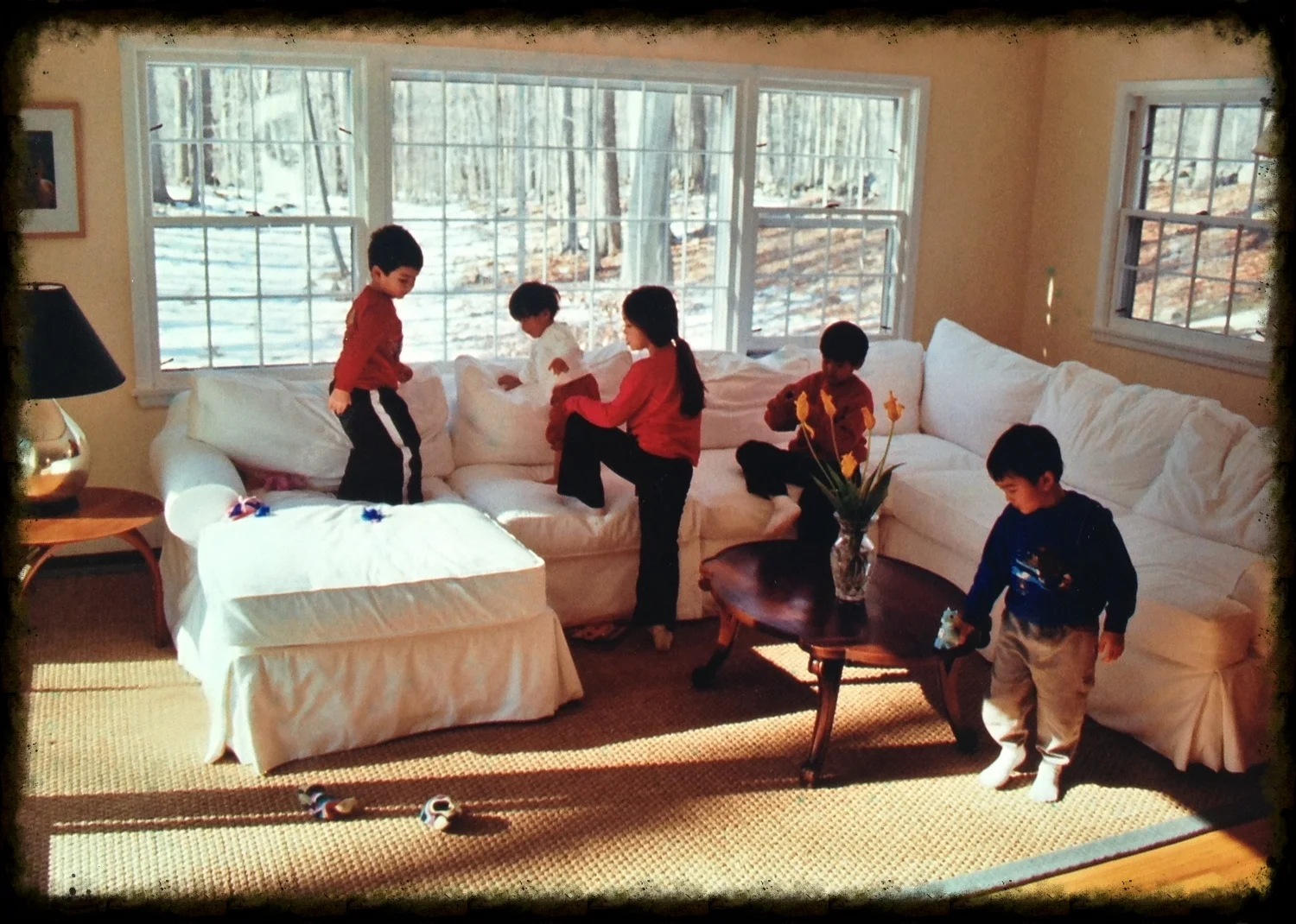1 Sofa, 3 Kids & 51 Pen Marks
When my mother saw the new sofa, she said I was crazy. It was a pristine three piece sectional. A medium colored print would have been practical but I had always loved white upholstered furniture and when you are going to spend that much, shouldn’t you love it? (And I’m not that stupid -- I did have it slipcovered in cotton denim to withstand roughhousing.)
It was a thing of beauty, right?
I did love it and so did my kids who were then 7, 5 and 2. It was plush and comfy, and perfect for D.E.A.R. (Drop Everything And Read) time. But three weeks in, something happened and I went berserk.
Stepping behind the sofa one day to retrieve something, I noticed long blue pen marks on it. Each vertical line was over a foot long and there were f-i-f-t-y--o-n-e of them. I counted twice to make sure before launching my attack.
Before I describe that pretty scene, let’s fast forward. Today, as a certified P.E.T. instructor, I can see that we are operating in the Parent Owns Problem area of the Behavior Window. The skill called for is a Confrontive I-Message which, at its strongest, has three parts:
- Non-blameful description of child’s behavior
- My primary, congruent feelings
- The concrete and tangible effects on me
My class members and I construct what COULD have happened. (First though, they admit that they would want to murder someone or cry for a month -- I definitely have company.) We come up with the following:
- I could have looked past my rage to my underlying primary emotions -- frustration, helplessness, sadness.
- I could have shown through my non-verbal behavior just how upset I was (congruence is showing on the outside exactly how I feel on the inside) -- usually I act this out by crumpling up on the floor with head in hands, emitting a low “Oooohhh nooooo.”
- I could have said: “I don’t like it when someone draws with a pen on our new sofa. I feel so sad and upset and frustrated because I waited so long for it to come and I was really enjoying it! Now I will have to spend a lot of money getting it cleaned!"
Coulda, woulda, shoulda. Nothing remotely like that transpired. Instead, I did a Roadblock Mash-Up:
OH MY GOD! EVERYONE COME HERE RIGHT NOW! (Ordering) WHO DID THIS? (Interrogating) WHO . . . DID . . . THIS????? (Interrogating very slowly) . . . [silence on the part of three beautiful and terrified youngsters] . . . IF NO ONE IS GOING TO TELL THE TRUTH, THEN NO VIDEO GAMES FOR ONE MONTH! (Threatening)
Eventually, five year old Jake gingerly put up his hand. "Jake, how could you??!!" And then I punished them all anyway with no gaming for a week.
Now, Thomas Gordon says that effective confrontation does four things:
- Produces the helpful change I want
- Preserves the other’s self-esteem
- Maintains my relationship with that person
- Helps the other to grow
All my Roadblock Mash-up got me was #1 -- never again did anyone go near the furniture with a pen. But my angry You-Messages failed on all three other counts and only served to engender shame: You are a bad boy or girl for doing this!
This is where the Confrontive I-Message is vastly superior. It helps the child develop empathy (#4) by sharing your reality: how you feel and how his behavior impacted you. He may feel guilt or remorse but both have to do with discrete actions (rather than inherent "badness"), e.g."I wish I hadn’t done that." And the beauty of a Confrontive I-Message is that it assumes the child will want to change (#2) and offers him the chance to help you (#3).
But guess what: It wasn't even Jake!
Last year (6 years after the fact), he brought it up while we were driving:
Jake: “Mom, do you remember that white sofa and the marks?”
Me: “Heck yeah! That image is burned in my memory!”
Jake: “You know, I didn’t do it. I just didn’t want us all to be punished for a month like that.”
Well, knock me over with a feather! Of course I asked, “Who was it then?” “I don’t know,” came the answer. Later on, Harrison told me, “Mom, I was seven and I definitely didn’t do it.” That left Claudia who maintained, at 9, that she simply couldn’t remember if she’d done that at 2. I 100% believe her -- that traumatic event got quickly repressed is my guess. But I have to assume it was her.
Do I even need to know who did it? There's always one camp of parents that says no, all that matters is that the three kids hear how distressed I am and, with that new empathy, do not repeat the behavior.
But I'm in the other camp: I need to know! Not to punish but to understand and help.
By drawing on the furniture, my child (whoever it was) was simply fulfilling a need. (The central -- and radical at first for many parents, including me -- premise of P.E.T. is that everyone on this earth is simply acting to meet valid needs.)
So, assuming it was my toddler, I might guess that her needs were fun, creativity and discovery. I could then offer her alternatives to meet those needs, after enthusiastically and warmly enlisting her help to strip the sofa of its slipcovers etc.
If it were either of my school-aged sons, the inquiry would be different. I would Active Listen his behavior: "Something must have truly upset you that you did this. You seem really, really in turmoil!" Together we could spiral down to find these possible needs:
The oh-so-inviting back of the sofa
- Attention/Love - maybe I had been too preoccupied before the incident
- Fairness - maybe I had sided with his brother in an argument one too many times
- Understanding - perhaps I was not Active Listening him (quite likely since I had not yet taken P.E.T.!)
And then my son and I would problem-solve other ways he could let me know when he was feeling sad, upset, lonely, afraid or angry. Reaching for his own Confrontive I-Message before his emotions reached a boiling point, he might say: "Mommy, you always say Claudia is innocent because she is the baby! I feel really annoyed because it's not fair when I can't even tell you my side of the story!"
But none of this happened because we weren't a P.E.T. family yet. Children feel safe to ‘fess up in P.E.T. families because, instead of punishment, there is open discussion with an eye to meeting everyone’s needs. After the fires cool down, then we perform our duties as parents to guide and teach socially acceptable ways of expressing frustration. And we model these skills ourselves.
So what a chance at redemption I got when, a couple of weeks ago, Jake called me from home!
Jake: “Mom, you know the big white chair? . . . and you know the Orangina you bought?” (I wasn’t kidding when I said I love white furniture.)
Me (playfully): “Yes, Jake, and you would like me to put two and two together?”
Jake: “Yeah, I kinda spilled some Orangina. What should I do?”
I walked him through the time-saving strategy of tackling stains while they are fresh, and how to strip off the slipcovers and rinse them using a bit of handsoap. I asked him to inspect the underlying upholstery and to sop up any dampness with a dry towel and then to use a damp towel to try to get rid of any discoloration.
All the while, I was grinning with merriment. Jake had taken the initiative to call me right away. Even though he knew I was on the bus coming home, he did a thorough job getting the pale orange stains out. He appreciated that now I view him as a helper rather than a culprit. As Tara Brach said recently in an online mindfulness course: “Helping people to remember their goodness is the greatest gift we can give to each other.”
Now, it's true that it was just Orangina and I didn't have to confront him. But it's real nice knowing I would have a new and different response even if I came home to find red fruit punch on the chair. Or a fresh set of pen marks.
Jake in the Orangina-free clubchair
Learn more about when Confrontive I-Messages don't work.






